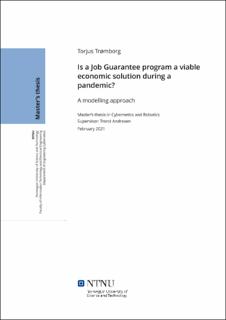| dc.contributor.advisor | Andresen, Trond | |
| dc.contributor.author | Trømborg, Torjus | |
| dc.date.accessioned | 2021-09-23T18:27:38Z | |
| dc.date.available | 2021-09-23T18:27:38Z | |
| dc.date.issued | 2021 | |
| dc.identifier | no.ntnu:inspera:66462738:20994502 | |
| dc.identifier.uri | https://hdl.handle.net/11250/2781034 | |
| dc.description.abstract | Økende arbeidsledighet er et globalt problem. Å gå arbeidsledig over lengre tid kan ha negative sosiale og økonomiske konsekvenser. Et Jobbgaranti-program kan være en løsning på verdens arbeidsledighetproblem. Jobbgaranti er en statlig finansiert, lokalt organisert jobb alle villige til og i stand til å jobbe kan få. Den tilbyr samme lønn uavhengig av profesjon, utdanning eller alder. Jobbtilbudene består av en «bank» av ledige jobber, med digital kurs og opplæring dersom en pandemi begrenser jobbmulighetene. I tillegg til fulltidsjobber, tilbyr Jobbgaranti-programmet også deltid for de som ikke kan jobbe 100%. Grunnlaget for jobbgaranti er Moderne Monetær Teori (MMT). Et av de viktigste målene til MMT er å oppnå full sysselsetting, hvor det ikke er noe problem å la staten gå med underskudd ifølge denne teorien, dersom det utnytter økonomiens fulle potensiale.
I denne masteroppgaven er to makroøkonomiske modeller av et samfunn utviklet ved hjelp av kybernetiske og samfunnsøkonomiske metoder, med en dynamisk tilnærming. En pandemi blir introdusert for å simulere en økonomisk krise. Den første modellen er et samfunn med null arbeidsledighet med et Jobbgaranti-program og inkluderer to støtteordninger under krisen for å dempe konsekvensene av pandemien. I den andre modellen er det ordinær arbeidsledighet og ingen støtteordninger. Pandemien har en lengde på 1.5 år, og simuleringen har en varighet på ti år for å observere den økonomiske dynamikken over tid.
Resultatene i denne oppgaven viser at et Jobbgaranti-program med støtteordninger demper størrelsene på svingningene i økonomien. Et Jobbgaranti-program skaper også et lavere underskudd for staten når den havner i en økonomisk krise som en pandemi, sammenlignet med en ordinær økonomi med tradisjonell arbeidsledighet. I tillegg til lavere kostnader over tid, kommer alle de positive sidene ved å ha en jobb fremfor å gå arbeidsledig i lengre perioder. Resultatene viser at forskjellen i totalt underskudd mellom økonomien med Jobbgaranti og økonomien med arbeidsledighet er 6.4 milliarder NOK i slutten av perioden. Underskuddet er 74% større på det meste i økonomien med arbeidsledighet sammenlignet med økonomien med Jobbgaranti. I gjennomsnitt er det 13.3% flere arbeidsledige i økonomien med arbeidsledighet enn personer i Jobbgaranti-programmet over en periode på 10 år. Det er 108 tusen flere mennesker som er arbeidsledige i uken enn antall mennesker i Jobbgarantien under pandemien.
Bidraget til eksisterende teori fra denne oppgaven er kvantiserte resultater som kan være grunnlaget for å teste og implementere jobbgarantier for å gjøre endringer mot en ny retning i den økonomiske fremtiden. | |
| dc.description.abstract | Rising rates of unemployment are a global problem. Being unemployed over a longer period can give negative social and economic consequences. A Job Guarantee program can be a solution to the world’s unemployment problem. Job Guarantee (Hereafter JG) is a federally funded, locally administrated job that everyone able and willing to work is offered. The JG employment gives the same wage irrespective of profession, education or age. The program serves as a repository containing different job opportunities, with digital courses and training if a pandemic restricts the number of opportunities. Besides full-time jobs, the JG program can also offer part-time jobs. Modern Monetary Theory (MMT) is the basis for a JG program. One of the most important goals of MMT is to achieve full employment, and government deficit is not a problem according to this theory if the economy’s full potential is utilised.
In this thesis, two macroeconomic models of a society are developed using cybernetic and economical methods, using a stock-flow approach. A pandemic is introduced to simulate an economic crisis. The first model is a society with zero per cent unemployment with a Job Guarantee program and includes two types of crisis support to limit the consequences of the pandemic. In the second model, there is regular unemployment and no crisis support. The pandemic has a length of 1.5 years, and the models simulate the economy over ten years to observe the economic dynamics over time.
The results in this thesis show that a Job Guarantee program with crisis support reduces the magnitude of the fluctuations in the economy. A JG program also creates a smaller deficit for the government when hit by a crisis like a pandemic compared to a “business as usual” situation with regular unemployment. The benefit of having a job instead of long-term unemployment is an additional benefit of the JG program. The results show that the difference in the total public deficit between the JG economy and the economy with unemployment is 6.4 billion NOK at the end of the period. The total deficit is 74 per cent larger at its maximum in the economy with unemployment compared to the economy with Job Guarantee. On average, there are 13.3 per cent more unemployed people in the economy with unemployment than people in the Job Guarantee program over the timespan of 10 years. There are 108 thousand more people unemployed per week than people in the JG program during the pandemic.
This thesis’ contribution to existing studies is the quantified results that can be used as a foundation for testing and implanting JG programs that can make changes towards a new way of economic future. | |
| dc.language | eng | |
| dc.publisher | NTNU | |
| dc.title | Is a Job Guarantee program a viable economic solution during a pandemic?
A modelling approach | |
| dc.type | Master thesis | |
